|
|
|
 |
|
|
|
|
|
|
|
Anchor Street
|
|
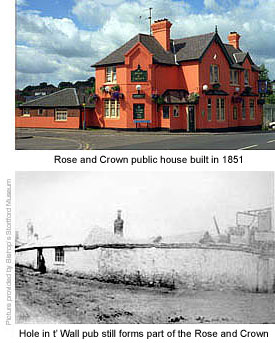 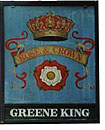 Prominent at the corner of Anchor Street and Station Road is the 19th century Rose and Crown public house. All that is really known of its early history is that it was kept in 1851 by a railway porter named William Myson, and that the single-storey out-house once formed part of a much earlier pub known as the Hole in t’ Wall. In the late 1800s land at the rear of the pub near to the river was occupied by Jackson’s Yard, a place where farm wagons were repaired and hired. Prominent at the corner of Anchor Street and Station Road is the 19th century Rose and Crown public house. All that is really known of its early history is that it was kept in 1851 by a railway porter named William Myson, and that the single-storey out-house once formed part of a much earlier pub known as the Hole in t’ Wall. In the late 1800s land at the rear of the pub near to the river was occupied by Jackson’s Yard, a place where farm wagons were repaired and hired.
The high brick wall bordering part of Anchor Street was built in the 1800s to enclose the railway goods yard – now the station car park – and when the town’s first gas lamps were lit in 1835, their supply was generated from here by the newly established Bishop's Stortford Gas Company. Built the previous year on land alongside the river, this road leading to it was named, not surprisingly, Gas Works Lane. It was renamed Anchor Street when the gas works was re-sited at South Road in the early 1900s.
The vacant site was finally utilised in 1966 by the building of a college for the training of apprentices and engineers in the Gas industry, previously located at North Watford. Named the John Dyde Training College after John H Dyde, Chairman of Eastern Gas at that time, the college operated for about 25 years. Cost-cutting and restructuring within the gas industry in the early 1990s inevitably led to its closure and eventual demolition in 1998, and in 2004 work began on the site to erect 208 private apartments in several blocks. The work was completed in 2006.
In 1907, Anchor Street was the scene of a fire the likes of which this town had never seen before, or since. When two patrolling policeman spotted sparks flying from windows of Anchor Street maltings in the early hours of December 2nd that year, they immediately alerted the local fire brigade. The railway fire service also assisted with the task but the blaze took such a hold that fire crews from Broxbourne, Ware, Cambridge and Sawbridgeworth were also asked to attend.
The combined force coped well with the blaze but when a sudden change in wind direction threatened the nearby gas works, it was feared the flames would cause a massive explosion. To everyone's relief the danger passed, but by morning all that remained of the malting was burning embers. As a reward for their marathon efforts, fire crews were given a barrel of beer by a local man named Colonel Healey.
The fear of an explosion if the nearby gas works had caught fire was later proved unfounded, because coal gas in bulk does not explode when fired. However, the blaze did cause £35,000 of damage – the equivilant today of £3.5m. No photographic record of the actual fire exists but a local artist, who no doubt witnessed the event, later painted a very realistic image of the scene. MORE PICTURES
|
|
|
|
Leisure Centre
|
|
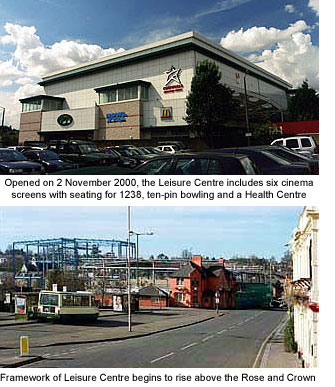 Up until 1958, Bishop’s Stortford boasted two cinemas and regular entertainment in its various clubs and dance halls. Ironically, as the town’s population grew in the 1970s, social amenities rapidly declined and local entertainment was generally limited to a night out in a local pub. Admittedly there were lots of pubs to chose from but for the more adventurous and mobile, even a night out at the cinema meant travelling to distant towns. Not until the late 1990s was the public’s constant cry for local leisure facilities finally answered. Up until 1958, Bishop’s Stortford boasted two cinemas and regular entertainment in its various clubs and dance halls. Ironically, as the town’s population grew in the 1970s, social amenities rapidly declined and local entertainment was generally limited to a night out in a local pub. Admittedly there were lots of pubs to chose from but for the more adventurous and mobile, even a night out at the cinema meant travelling to distant towns. Not until the late 1990s was the public’s constant cry for local leisure facilities finally answered.
After several false starts, construction of this £11m leisure complex finally got under way in October 1999 and was completed the following year. Managed by Bishop’s Stortford Leisure Corporation Limited, the complex comprises of six movie screens, a twelve lane bowling alley, restaurants, bar and fitness suite. Although extremely welcome for the facilities it provides, this building is not the most elegant of structures and does little to enhance this part of town. MORE PICTURES
|
|
|
|
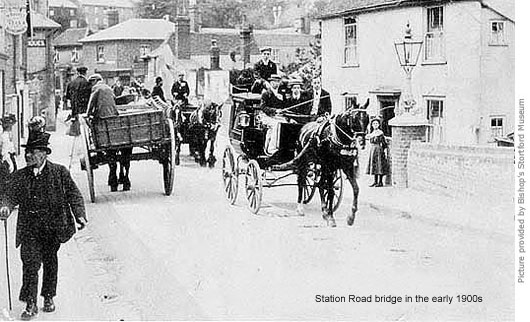 |
|
|
|
Up until the mid 1800s, entrance to the town from the station was either via Dell Lane (now Dane Street) and Causeway, or by paying a halfpenny to Newman's ferry service for the pleasure of being rowed across the river by boat – a distance of some 10 metres. The service, which operated daily between the Hockerill side of the river and a dilapidated building in Catherine Wheel Alley, then situated adjacent to the present bridge on the south-west side, was, no doubt, a lucrative business for Mr Newman.
But with the arrival of the railway in 1842 and the subsequent building of New Town, it soon became apparent that a ‘proper’ river crossing was needed for the town’s growing population and that Mr Newman would have to find other ways of earning a living. Surprisingly, perhaps, the task of funding and building a bridge was not taken on by the Vestry or the Highway Board, but by a private committee who raised the money by public subscription. Furthermore, on completion of the bridge in 1866 it was then handed over to the authorities of the town free of all liability.
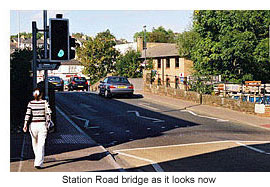 Inevitably the new road linking South Street with the station was named New Bridge Street, but this later changed to Station Road. Flank walls on either side of the bridge were originally supported by round brick pillars, each with a gas lamp on top to light the way. Alterations and strengthening of the structure has since done away with most of the original brickwork, leaving just one pillar remaining – but not its gas lamp! Inevitably the new road linking South Street with the station was named New Bridge Street, but this later changed to Station Road. Flank walls on either side of the bridge were originally supported by round brick pillars, each with a gas lamp on top to light the way. Alterations and strengthening of the structure has since done away with most of the original brickwork, leaving just one pillar remaining – but not its gas lamp!
MORE PICTURES
|
|
|
|
[ BACK TO TOP ] |
|
|
|
|
|
|
|
|
|





 Prominent at the corner of Anchor Street and Station Road is the 19th century Rose and Crown public house. All that is really known of its early history is that it was kept in 1851 by a railway porter named William Myson, and that the single-storey out-house once formed part of a much earlier pub known as the Hole in t’ Wall. In the late 1800s land at the rear of the pub near to the river was occupied by Jackson’s Yard, a place where farm wagons were repaired and hired.
Prominent at the corner of Anchor Street and Station Road is the 19th century Rose and Crown public house. All that is really known of its early history is that it was kept in 1851 by a railway porter named William Myson, and that the single-storey out-house once formed part of a much earlier pub known as the Hole in t’ Wall. In the late 1800s land at the rear of the pub near to the river was occupied by Jackson’s Yard, a place where farm wagons were repaired and hired. Up until 1958, Bishop’s Stortford boasted two cinemas and regular entertainment in its various clubs and dance halls. Ironically, as the town’s population grew in the 1970s, social amenities rapidly declined and local entertainment was generally limited to a night out in a local pub. Admittedly there were lots of pubs to chose from but for the more adventurous and mobile, even a night out at the cinema meant travelling to distant towns. Not until the late 1990s was the public’s constant cry for local leisure facilities finally answered.
Up until 1958, Bishop’s Stortford boasted two cinemas and regular entertainment in its various clubs and dance halls. Ironically, as the town’s population grew in the 1970s, social amenities rapidly declined and local entertainment was generally limited to a night out in a local pub. Admittedly there were lots of pubs to chose from but for the more adventurous and mobile, even a night out at the cinema meant travelling to distant towns. Not until the late 1990s was the public’s constant cry for local leisure facilities finally answered. Inevitably the new road linking South Street with the station was named New Bridge Street, but this later changed to Station Road. Flank walls on either side of the bridge were originally supported by round brick pillars, each with a gas lamp on top to light the way. Alterations and strengthening of the structure has since done away with most of the original brickwork, leaving just one pillar remaining – but not its gas lamp!
Inevitably the new road linking South Street with the station was named New Bridge Street, but this later changed to Station Road. Flank walls on either side of the bridge were originally supported by round brick pillars, each with a gas lamp on top to light the way. Alterations and strengthening of the structure has since done away with most of the original brickwork, leaving just one pillar remaining – but not its gas lamp!